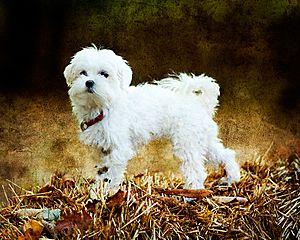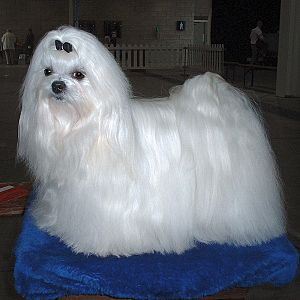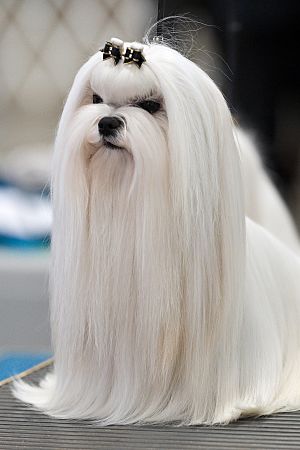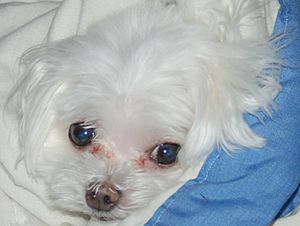Maltese (dog) facts for kids
The Maltese is a small, fluffy dog breed. It first came from the area around the Mediterranean Sea. Long ago, traders from Phoenicia might have brought these dogs from Ancient Egypt. Some old statues found in the tomb of Ramesses II look a lot like Maltese dogs! The name "Maltese" might even come from the island of Mljet, which is near Dubrovnik. These dogs are quite small, usually growing to about 25 centimeters (10 inches) long and weighing up to 4 kilograms (9 pounds).
Contents
All About the Maltese Dog
The Maltese breed has been officially recognized by big dog clubs for a long time. For example, the American Kennel Club first recognized them way back in 1888. This means there are special rules and standards for what a Maltese dog should look like and act like if it's going to be a show dog.
What Maltese Dogs Look Like
Maltese dogs have a few special features. Their heads are a bit rounded on top, and they have a cute black nose that looks like a button. Their eyes are usually brown. They typically stand about 18 to 25 centimeters (7-10 inches) tall.
Their bodies are compact, meaning they are about as long as they are tall. Their tail almost always curls over their back. They have floppy ears that are often covered with long hair. Sometimes, the skin around their eyes is darker, which makes their eyes look even more expressive!
If a Maltese doesn't get much sunlight, its nose can sometimes turn pink or light brown. People call this a "winter nose." But don't worry, it usually turns black again when they get more sun. Their paws are also very sensitive to touch.
Their Coat and Color
The Maltese dog has a long, silky coat that is pure white. It doesn't have a fuzzy undercoat like some other dogs. This is great because it means they don't shed much hair. This makes them a good choice for people who have allergies to dogs.
Sometimes, a Maltese might have a very light ivory color on its ears, which is usually okay. In some dog shows, a tiny bit of lemon color is allowed on their pure white coat.
Many owners like to keep their Maltese's coat short. A popular haircut is called "the puppy cut." This is when all the hair on their body, legs, chest, and head is trimmed short, usually less than 2.5 centimeters (an inch) long. It makes them look like a cute puppy all the time!
How Big Are They?
Adult Maltese dogs usually weigh between 2 to 4.5 kilograms (3 to 10 pounds). However, most dog clubs prefer them to be a bit lighter, often between 2 to 3.5 kilograms (4 to 7 pounds). They usually stand about 18 to 30 centimeters (7 to 12 inches) tall.
How They Move
Maltese dogs move in a very lively and smooth way. When you watch them from the side, they look like they are moving very quickly, especially for their size! Their front legs reach out straight from their shoulders, and their back legs move in a straight line too.
Maltese Dog Personality
Maltese dogs are bred to be companion dogs, which means they love being with people. They are super lively and playful! Even as they get older, they usually stay energetic and playful.
Sometimes, a Maltese might be a bit snappy with very small children. So, it's a good idea for adults to watch them when they play. If you teach them how to act nicely when they are young, they will be much better with kids.
Maltese dogs really love humans and prefer to stay close to them. They are very active inside the house and like small, enclosed spaces. This means they do very well in apartments or townhouses, which is why many people in cities love them as pets. Some Maltese dogs can get a bit anxious if they are left alone too much.
Sadly, some Maltese dogs are given up by their owners because they bark a lot. This breed is known for being quite vocal.
How to Care for a Maltese
Since Maltese dogs don't have an undercoat and don't shed much, they are often considered to be hypoallergenic. This means many people who are allergic to other dogs might not be allergic to a Maltese.
They need regular cleaning to prevent dark stains from tears around their eyes. Many owners find that bathing them once a week helps keep their coat clean. However, it's usually enough to wash them every three weeks, or even less often if they stay clean. They also need to be professionally groomed about every month and a half.
Regular grooming is important to stop their long hair from getting tangled and matted. Some owners like to keep their Maltese's hair clipped short in a "puppy cut" to make grooming easier. Other owners, especially those who show their dogs, will wrap the long fur to protect it. Then, for shows, they unwrap and comb out the hair to its full length.
Dark stains under the eyes, called "tear staining," can be a common issue for Maltese dogs. This happens because of how much their eyes water and the size of their tear ducts. You can find special solutions or powders at pet stores to help clean these stains. Also, using a fine-toothed metal comb moistened with warm water a couple of times a week can help a lot.
Maltese dogs can also have something called "reverse sneezing." This sounds like a honking or snorting noise. It often happens when they get very excited, play a lot, have allergies, or when they first wake up. It's not dangerous and usually goes away in about a minute.
How Smart Are They?
In a book called The Intelligence of Dogs by Stanley Coren, Maltese dogs are ranked 59th out of 79 breeds. This ranking mostly looks at how well a dog breed can learn and follow commands. It doesn't really measure other types of intelligence, like how good they are at understanding feelings.
Images for kids
See also
 In Spanish: Bichón maltés para niños
In Spanish: Bichón maltés para niños









